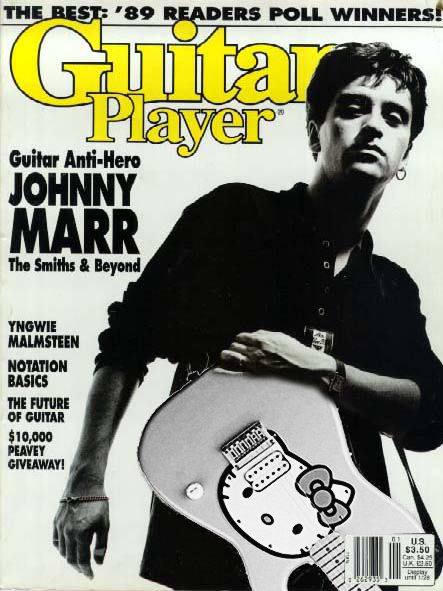Maybe it’s because of the crescendo of chatter about a Smiths reunion, but I’ve had Johnny Marr on the brain lately. (Full disclosure: I am a total, drooling fan.) I keep coming back to how deceptively simple his parts are, with an emphasis on the “deception” part. There’s always much more happening than initially meets the ear.
Perfect example: “This Charming Man,” the band’s first single. It’s always been my favorite Smiths guitar performance — even more than the apocalyptic tremolo and harmonizer work of “How Soon Is Now?” Maybe it’s because I’m still astounded by the originality and sheer chutzpah of the young guitarist, who was all of 19 when the track was released.
“This Charming Man” is a perfect little pop guitar part, with an African highlife-inflected head and lots of pretty open-string chiming throughout. But the deeper you dig, the more you uncover. And you won’t believe what I uncovered during my latest Smiths geek-out:
I was prowling for Smiths content on YouTube, when I stumbled across this:
Yep — some unnamed benefactor has leaked the individual instrumental stems of this remarkable single. I’ve written previously about the series of illicitly leaked individual tracks from classic rock recordings available on the web, usually via the keywords “mutlitrack masters.” (I won’t bore you again with the whole intellectual property argument — suffice it to say, I support these releases on educational grounds.) And this leak is a prize!
Here’s what Johnny told me about the performance when I interviewed him in ’89, just after the Smiths broke up:
“‘This Charming Man’ was the first record where I used those highlife-sounding runs in 3rds. I’m tuned up to F# and I finger it in G, so it comes out in A. There are about 15 tracks of guitar. People thought the main guitar part was a Rickenbacker, but it’s really a ’54 Tele. There are three tracks of acoustic, a backwards guitar with a really long reverb, and the effect of dropping knives on the guitar — that comes in at the end of the chorus.”
Seriously — unless you read that, would it ever have occurred to you that there were 15 guitar tracks? Even after spending the intervening years listening for everything Johnny described, I still couldn’t hear it. Till now.
Curious about those acoustic guitars and backward-reverb sounds? We’ve got those too!
And yes, I can finally hear those dropping knives! Naturally, it’s on the open F#m chord (fingered as Em in Marr’s F# tuning).
There are so many awesome details here: the not-quite perfectly doubled Telecasters. A thin, acidic bridge pickup tone that most players with “good taste” would scorn. The subtle changes in the acoustic guitar groove. The dissonant arpeggio and sweet harmonics in the chorus. The isolated tremolo accent. (And if you listen on headphones, you’ll hear all the headphone leakage that accumulated over the course of those ambitious overdubs.)
My takeaway for today: Subliminal parts can be meaningful. Johnny talked about how he loved Roxy Music’s albums, because every listening uncovered previously unnoticed details. It’s those subtle, mysterious elements that keep the song so engaging after 30 effin’ years.
Let’s give Johnny the last word: Here’s a clip from a 2007 BBC documentary where he demonstrates the song’s main riffs — but sadly, not the knife-dropping part.









effin’ brilliant that………effin’ brilliant :thumbup:
Yeah, I hate talented little %$^&*@s like Johnny.
I’m reading the blog since its begin, and for me the posts are getting better and better, I even get excited when i see a new one.
It’s just my eyes or Johnny is using a beer bottle strap lock like these https://www.tonefiend.com/guitar/stap-lock-free-with-every-beer/ ?
Cheers !
Oh, didn’t you know? You get a free case of Grolsch with every Hello Kitty guitar.
Thanks for the kind words about the blog, Labes. 🙂
fantastic!! this is a wonderful article/lesson (yes, it IS a lesson!). i’m a huge Marr/Smiths fan and have always read the stories of his mythically layering tracks; but, despite many listenings, i could never actually HEAR it until now. insane. he was just a kid too, for crying out loud!
Well, a lot of players have acquired great technical skill by their late teens. But how many have developed such a big-picture view? A sense of orchestration? A distinctive style? A willingness to break “rules?” Go, Johnny, go! 🙂
Wow. I’ve always been a huge fan of Marr, and this is really killer stuff!! Now I want to hear all the guitar parts alone…
Thanks for sharing this, Joe!
Essential reading for Marr fans:
https://foreverill.com/interviews/post87/antihero.htm
Great post, Joe! Those multitracks are from Rock Band. There are also some out there for Stop Me If You’ve Heard This One Before. You should check out my site, Smiths On Guitar… I have a pretty definitive gear section there that you would enjoy.
Quick question… do you have any notes or nuggets that didn’t make the edit from the 1989 interview?
Great post!